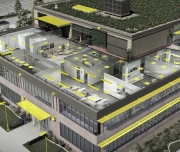System Impacts
Resources Impact
The lighting system has a tremendous impact on building resources, primarily through the electricity and associated energy it demands. Designing, implementing, and maintaining a lighting system that focuses on best practices for reducing the energy needed for proper indoor and outdoor illumination will have a considerable effect in achieving sustainability and reducing utility and operating costs.
Best Practices and Strategies
| Limit internal “night lighting” by utilizing occupancy sensors (currently allowed by safety codes) during off-peak hours. | Reduce electrical lighting consumption and associated waste heat by pairing harvested daylight with automated dimmers and photosensors. | Replace low-efficiency lighting technologies (incandescent, fluorescent, etc.) with higher efficiency, longer lasting LEDs. |
| Limit the use of accent lighting. Couple necessary accent lighting applications with lighting controls to ensure highlighted objects are illuminated or illuminated at full power only when occupants are nearby. | Avoid over-lighting by delivering the amount and quality of light necessary for the particular task. | Employ a layers of light approach - using daylighting for basic ambient light levels while providing occupants with additional lighting options to meet their needs. Find more. |
| Allow optimal daylight penetration, orientating interior space layout accordingly. | Utilize sub-meters to monitor electricity use and use this data to identify waste and maintenance concerns. | Commission all lighting systems including controls to ensure they are performing as required and create a retro-commissioning to maintain the desired level of performance. |
Additional Resources
- GSA | The Fort Carson Energy Research Project: Daylighting and Lighting System Performance

- GSA | Saving Energy through Lighting and Daylighting Strategies

- DOE | Energy Efficiency and Renewable Energy (EERE) Building Technologies Office (BTO)

- WBDG.org | Daylighting

- WBDG.org | Energy Efficient Lighting

- DOE | ENERGY STAR Building Upgrade Manual: U.S. Lighting Market Characterization - Volume 1 - National Lighting Inventory And Energy Consumption Estimate (2002)


